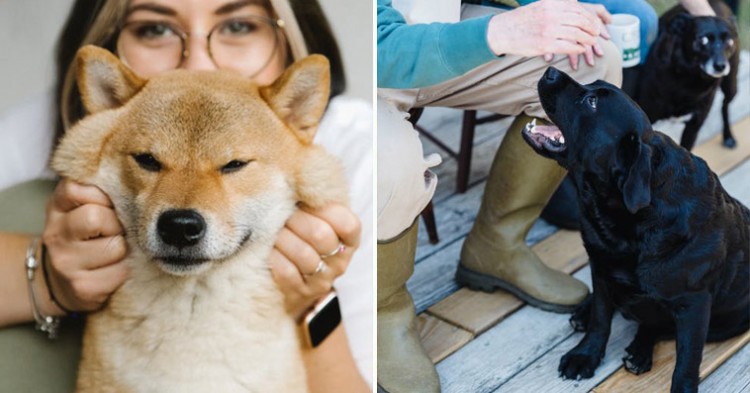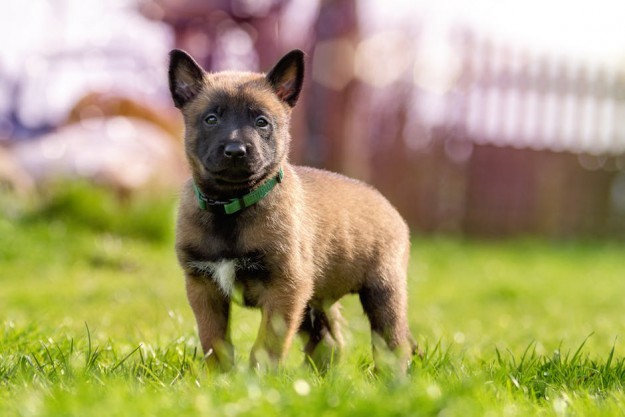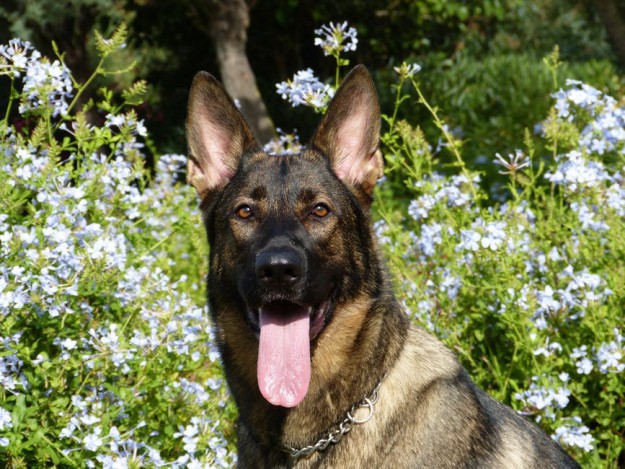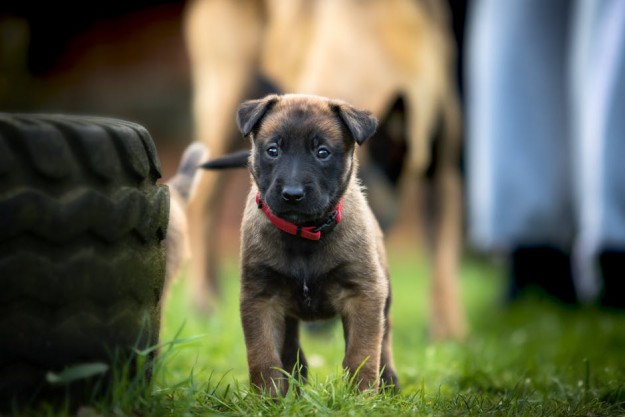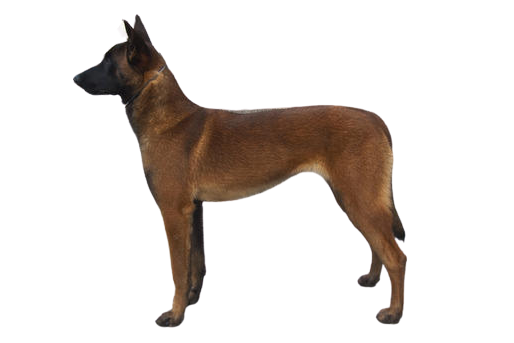
Belgian Malinois
USD $1200-$1400 Price Avg.
Pastoral Dogs (Herding Dogs)
Group
Purebred
Breed Type
Large
Size
12-14 years
Lifespan
Breed Information
| Group | Pastoral Dogs (Herding Dogs) |
|---|---|
| Popularity/Rank | 44 |
| Origin | Belgium |
| Other Names | Malinois |
| Breed Type | Purebred |
| Price (Avg.) |
USD $1200-$1400
How much does it cost to purchase a Belgian Malinois? The price of a Belgian Malinois will vary from breeder to breeder as well as from place to place. As a rough guide, you should expect to pay between $1200 to $1400 per Belgian Malinois if you purchase from a reputable breeder. Prices will be higher for show-quality dogs with a distinguished pedigree. Adult dogs who have already been trained may cost even more. It is usually less expensive to adopt a Belgian Malinois through a shelter. |
| Size | Large |
| Weight |
Male: 65-75 pounds (29-34 kg),
Female: 60-70 pounds (27-32 kg) |
| Height |
Male: 24-26 inches (61-66 cm),
Female: 22-24 inches (56-61 cm) |
| Lifespan | 12-14 years |
| Recognized by |
AKC
The American Kennel Club in 1959 as a Herding breed. And Not recognized by FCI. |
| Purpose | Stock Herding |
| Date of Origin | 1800s |
| Ancestry | Shepherd Dog |
Appearance & Maintenance
| Coat | Straight, Weather-resistant |
|---|---|
| Coat Colors | Black, Brindle, Cream, Fawn |
| Grooming Level | |
| Shedding Level | |
| Eye Color Possibilities | Brown |
| Nose Color Possibilities | Black |
| Coat Color Possibilities | Brown, Fawn, Sable |
| Coat Length | Medium |
| Coat Density | Normal |
| Coat Texture | Straight |
| Recommended Brushes | Comb, Nail Clipper, Pin Brush, Scissors, Slicker Brush |
| Brushing Frequency | Weekly |
Breed Characteristics
| Temperament | Active, Alert, Aware, Confident, Defensive, Friendly, Hard working, Protective, Stubborn, Vigilant, Watchful |
|---|---|
| Intelligent | |
| Trainability | |
| Playfulness | |
| Sensitivity Level | |
| Affection Level | |
| Social Interaction Required | |
| Barking | |
| Watchdog Ability | |
| Territorial | |
| Biting Force | Low |
| Mouthiness | |
| Impulse to Wander or Roam | |
| Prey Drive | |
| Adaptability | |
| Tolerates Being Left Alone | |
| Fighting Dog | Not really |
Good & Friendly with
| Apartment Life Friendly | |
|---|---|
| Stranger Friendly | |
| Kid-Friendly | |
| Cat Friendly | |
| Dog Friendly | |
| Office Friendly | No |
| Senior Citizens Friendly | |
| Pet Friendly | |
| Friendly with First Time Owners | No |
| Service Dog | Yes |
| Therapy Dog | Not really |
| Detection, Sniffer or Security Dog | Yes |
| Search and Rescue Dog (SAR) | Yes |
| Boat Dog | Not really |
| Cart Pulling or Drafting Dog | Not really |
Health Elements
| Health Issues | |
|---|---|
| Health Problems | Elbow Dysplasia, Epilepsy, Eye Problems, Hip Dysplasia |
| Hypoallergenic | No |
| Energy Level | |
| Exercise Required | |
| Sleeping Required | |
| Weight Gain Potential | |
| Weather & Climate | Tolerates warm and cold weather. |
| Stinkiness | Medium |
| Drooling tendency | |
| Activity Level | High |
| Rec. Walk Mileage Per Week | 12 miles |
| Minutes of Activity Per Day | 60 minutes |
Food & Costing
| Avg. Daily Food | 2 to 3 cups of high-quality dry food a day, divided into two meals. |
|---|---|
| Cups Per Day | 3 cups |
| Daily Cost | $1.50 - $1.90 |
| Monthly Cost | $39.00 - $52.00 |
Reproducibility
| Gestation Duration | 60-64 days |
|---|---|
| How often can the Belgian Malinois have a litter? | Once a year. |
| Litter Size | 6-10 puppies (Once a year.) |
Description
The Belgian Malinois is a medium-sized breed of dog that originated in Belgium. It is a member of the herding group and is known for its intelligence, loyalty, and protective nature. The breed has become increasingly popular in recent years due to its use as a working dog by law enforcement and military organizations around the world.
Appearance: The Belgian Malinois has a short, thick coat that can be either fawn or mahogany in color with black masking on the face and ears. The coat may also have white markings on the chest, feet, and tip of the tail. The breed has an athletic build with strong legs and a deep chest. Its head is wedge-shaped with erect ears that are set high on the head.
Lifespan, Size, Weight & Colors: The average lifespan of a Belgian Malinois is between 10-14 years when properly cared for. They typically weigh between 40-80 pounds (18-36 kg) and stand 22-26 inches (56-66 cm) tall at the shoulder. In addition to fawn or mahogany coats, they may also have white markings on their chest, feet or tail tip.
Personality: Belgian Malinois are highly intelligent dogs that are eager to please their owners and learn new tasks quickly. They are loyal companions who form strong bonds with their families but can be wary of strangers if not properly socialized from an early age. They thrive when given plenty of mental stimulation through activities such as agility training or obedience classes as well as physical exercise like running or playing fetch games in an open area like a park or beachfront property
Friendliness: Belgian Malinois are generally friendly towards other dogs but should always be supervised when interacting with unfamiliar animals due to their protective nature towards their family members which could lead to aggressive behavior if provoked by another animal’s aggression towards them first . They tend to get along well with children if raised together from puppyhood but should still be monitored closely during playtime due to their size and strength which could lead to accidental injury if not handled carefully . As far as other animals go , they usually do best when kept away from cats , rabbits , rodents , birds , reptiles etc .
Temperament: This breed tends to have an independent streak which can make them difficult to train at times but they respond best when given consistent positive reinforcement methods such as treats or praise . They need firm leadership from an experienced owner who understands how important it is for them to feel secure within their pack structure . If left alone too often without proper mental stimulation they may become bored which could lead them into destructive behaviors such as chewing furniture or digging holes in your yard .
Health : Generally speaking , this breed does not suffer from any major health issues however some individuals may develop hip dysplasia over time so it’s important for owners to keep up regular vet checkups throughout their life span . Additionally , because this breed was bred for work purposes they tend to have higher energy levels than other breeds so it’s important for owners provide plenty of physical exercise each day such as long walks/runs/hikes etc .
Adaptability : This breed does best in homes where there is someone home most days out of the week since they crave companionship more than anything else . Additionally , because this breed was bred for work purposes they do better in homes where there are plenty of activities available such as agility courses/obedience classes/etc so that they can stay mentally stimulated throughout each day .
Benefits : There are many benefits associated with owning a Belgian Malinois including its intelligence level which makes it easy for owners teach basic commands quickly ; its loyalty towards family members ; its protective nature ; its ability adaptable environment ; its high energy level making it great companion those looking active lifestyle; lastly -its overall good health making it less likely suffer from major medical issues over time compared other breeds
History
The Belgian Malinois is a breed of dog that is native to Belgium. The breed is named after the city of Malines, where it was first developed. The Belgian Malinois is a member of the herding group of dogs and was originally bred for herding sheep and other livestock. The breed almost became extinct in the early 1900s due to a lack of interest in the breed. However, the Belgian Malinois was saved from extinction by a few dedicated breeders who continued to breed the dogs. In recent years, the Belgian Malinois has become a popular breed due to its working ability and its resemblance to the German Shepherd Dog. The Belgian Malinois is recognized as a separate breed by most major kennel clubs including the American Kennel Club, the United Kennel Club, and the Canadian Kennel Club.
The Belgian Malinois is thought to be descended from several different breeds of herding dogs including the German Shepherd Dog, the Dutch Shepherd Dog, and the French Briard. The exact ancestry of the Belgian Malinois is unknown but it is believed that the breed was developed in Belgium in the late 1800s or early 1900s. The first recorded mention of the Belgian Malinois was in an article published in 1898. The article described a dog that resembled a German Shepherd Dog but was smaller in size and had a shorter coat. In 1901, another article was published which described a similar type of dog but with longer hair on its legs and tail. These two articles are thought to be among the first recorded mentions of what would eventually become known as the Belgian Malinois.
The Belgian Malinois almost became extinct in Belgium during World War I due to a lack of food and resources. However, some dedicated breeders continued to keep and breed the dogs during this time period. After World War II ended, interest in breeding dogs increased and more people began breeding Belgian Malinois again. In recent years, there has been an increase in popularity for working dogs such as police dogs and military working dogs. This has led to an increase in popularity for breeds such as the German Shepherd Dog and Dutch Shepherd Dog which are similar to the Belgian Malinois.
Belgian Malinois Posts
Explore Belgian Malinois's photos, videos, activities, stories, and facts.




